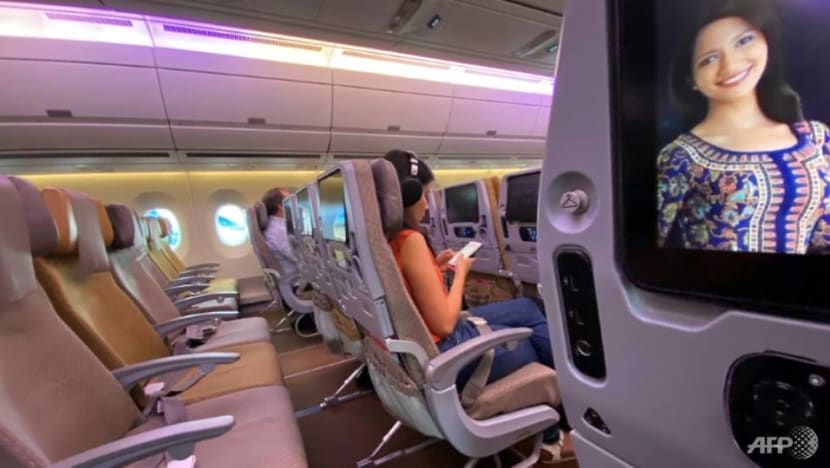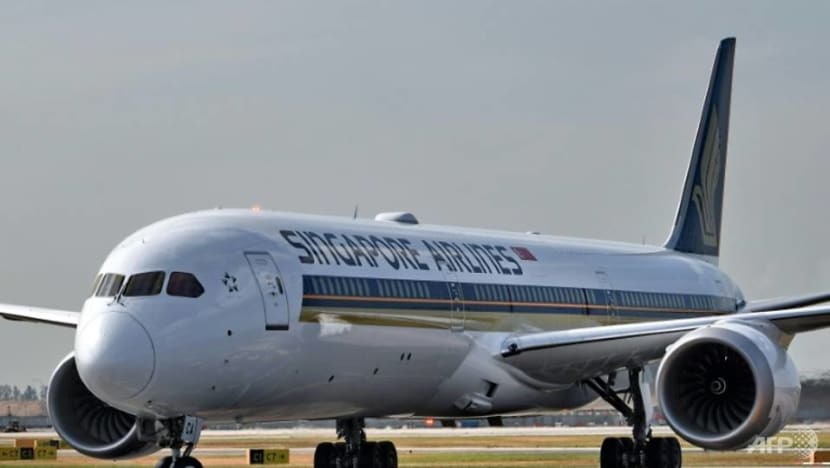commentary Commentary
Commentary: The outlook for Singapore Airlines has gone from bad to worse
Singapore Airlines Group and Changi Airport passenger traffic could remain at 1 per cent of normal levels for at least several more months, says Brendan Sobie.

An Airbus A380-800 aircraft of Singapore Airlines takes off from Zurich airport, Apr 9, 2019. (Photo: REUTERS/Arnd Wiegmann)
SINGAPORE: The second half 2020 outlook for Singapore Airlines (SIA) and Singapore’s aviation sector has gone from bad to worse over the last few months due to a slower than initially expected resumption of international air travel.
Passenger traffic is likely to remain at around 1 per cent of normal levels until travel bubbles are established that go beyond essential business traffic and do not have onerous restrictions, including quarantine requirements, which inhibit demand.
CURRENT ARRANGEMENTS INSUFFICIENT
Travel bubbles or green lanes would facilitate a partial recovery but so far only two have been established and neither will drive significant passenger traffic.
The “fast lane” between Singapore and China was implemented in early June but has generated very little traffic given numerous restrictions and limitations.
There are currently only 11 weekly flights from Singapore to mainland China, including four by the SIA Group and seven from Chinese carriers.
The frequency of flights is insufficient to support two-way business travel, which the fast lane was set up for, and almost all the passengers on the limited flights now consist of students or workers heading home or back to school and work.
READ: Commentary: Here's how Singapore can take the reins of opening up travel bubbles safely
READ: Commentary: Tourism’s collapse could worsen the economic crisis we face
The Reciprocal Green Lane (RGL) with Malaysia that is being implemented later this month is limited to only 400 business travelers per week.
There is a separate Periodic Commuting Arrangement (PCA) with a much larger quota of 2,000 travelers per day but this is limited to commuters – Malaysians working in Singapore or Singaporeans working in Malaysia – using the two land borders to return home for visits a maximum of once every three months.
For the RGL, travelers can fly or use the land borders with applications being accepted by both countries from Aug 10, but the tiny quota will result in very limited demand for flights.
TRAFFIC TO MALAYSIA STILL LOW
There are currently 17 weekly flights from Singapore to Malaysia: 11 by the SIA Group – eight to Kuala Lumpur and one each to Ipoh, Penang and Kuching – four by Malaysia Airlines to Kuala Lumpur and two by Jetstar Asia to Kuala Lumpur.
AirAsia has announced the resumption of flights to Singapore from Aug 17 with an initial schedule of 11 weekly flights, including seven from Kuala Lumpur and one each from Ipoh, Kuching, Kota Kinabalu and Penang.
LISTEN: What next for Malaysian workers stuck there and Singapore businesses who hire them here?
READ: AirAsia to resume Malaysia-Singapore flights following 'green lane' decision
Malaysia’s Malindo also has announced the resumption of flights to Singapore from Aug 18 with one daily flight from Kuala Lumpur.
However, the combined 35 weekly Singapore-Malaysia flights, now scheduled from mid-August, will have very light loads given the RGL will generate at most 800 passengers per week.

Malaysia and Singapore will need to expand the RGL quota or open up PCA to include air travel for 35 weekly flights to be supported.
Airlines are hoping the PCA will permit flights in the future given that a large portion of Malaysians working in Singapore are not from Johor.
However, it could be several months before the PCA is expanded and onerous restrictions, including multiple PCR tests and stay home notices, could also impact demand.
REGIONAL LEISURE TRAVEL IS KEY
Other green lanes are under consideration but, if implemented, are also likely to have a minimal impact on air traffic given the limitations and restrictions.
Second waves in several countries are also impacting the possible timing of establishing more green lanes.
READ: Commentary: To facilitate regional air travel again, ASEAN needs to harmonise standards
The prospects of green lane or travel bubbles that generate significant passenger traffic are grim for at least the remainder of 2020, resulting in a gloomy outlook for Changi Airport and the SIA Group.
The outlook for 2021 is also now bleak as international travel may not start to recover in earnest until there is a vaccination.
Restarting leisure travel, which would result in more significant passenger traffic than essential business travel schemes, is potentially feasible during the pandemic by establishing protocols and programs.
For example, travel could be restricted to select destinations where the virus has been contained with passengers transported straight from the airport to specific resorts and not being permitted to leave the resort.
Several island destinations in ASEAN and Maldives could benefit from such a scheme, providing a safe holiday option for Singapore residents while generating additional traffic for airlines, airports and hotels to help the travel sector partially recover during this very challenging period.
LACK OF TRAVEL BUBBLES
However, so far there has been a lack of initiative to establish protocols and programs to restart leisure travel or international tourism within Asia.
Singapore may consider such schemes but forging agreements with other countries is a very slow process and a multilateral framework is really required for the current logjam to be broken.
The ASEAN Secretariat would be an ideal platform for facilitating the reopening of international travel but so far there has been no progress in establishing a multilateral framework for travel bubbles in Southeast Asia or Asia overall.
READ: Staycations and weekend getaways: Can domestic travel spark a revival of Southeast Asia’s tourism industry?
READ: Commentary: I used to think a staycation was a poor alternative for being overseas. Then I took one
Unfortunately, the SIA Group and Changi Airport passenger traffic will remain at 1 per cent, or at most 2 per cent, its normal level without meaningful travel bubbles open to a wider group of passengers.
MORE LOSSES AHEAD FOR SIA
The SIA Group carried only 38,000 passengers in the June quarter, a staggering 99.6 per cent decline compared to the same period last year, with an average load factor of only 10.2 per cent compared to 83.4 per cent a year ago.

Traffic is likely to only improve slightly in the current September quarter despite an increase in capacity as demand and load factors remain very low.
Only 33 of the group’s 213 passenger aircraft are currently being used for passenger flights, most of which are generating more cargo than passenger revenues.
SIA Group is also using 32 of its passenger aircraft and all seven of its freighters for cargo only-flights.
Cargo was profitable in the June quarter, helping partially offset huge losses which amounted to S$1.12 billion, including a S$464 million charge for fuel hedge ineffectiveness.
READ: COVID-19: More than 6,000 SIA Group staff members have taken no-pay leave since scheme introduced in March
READ: Most airlines expect job cuts over next 12 months: IATA survey
The fuel hedge ineffectiveness charge became necessary as SIA had to adjust capacity plans for the remainder of the current fiscal year due to the slower than expected recovery of the international market, resulting in a significantly lower projected fuel uplift and therefore a higher than initially expected fuel hedge surplus.
The S$464 million is on top of a S$710 million fuel hedge ineffectiveness charge for the current fiscal year that SIA was required to incur in March, when it was anticipating a faster recovery of the international market.
The SIA Group will likely incur an annual loss of roughly S$3 billion for the year ending March 2021. It incurred a S$212 million loss in the year ending March 2020 – SIA’s first ever annual loss – due to the initial fuel hedge ineffectiveness charge.
PROSPECTS REMAIN BLEAK
While the losses are staggering, SIA has raised S$11 billion in fresh liquidity since the beginning of the crisis and has an option to raise another S$6.2 billion using mandatory convertible bonds, giving it more than enough cash to ride out the current storm even with the bleaker than initially expected outlook for 2020 and 2021.
READ: Commentary: Airlines will need to review their fleets to boost passenger confidence and demand
READ: Commentary: Airline industry faces financial crisis with more bankruptcies looming
It would not be surprising if the SIA Group carries less than 1 million passengers in the current fiscal year. If it were not for COVID-19, it would have exceeded 40 million annual passengers for the first time.
The SIA Group is now unlikely to reach 40 million passengers until at least the fiscal year ending March 2023 and likely not until the year ending March 2024 or March 2025.
Changi’s passenger traffic for the calendar year 2020 will likely drop by over 80 per cent to roughly 12 million. Most of Changi’s traffic for the year was carried in the first quarter, when it handled 11.05 million passengers.
If it were not for COVID-19, Changi would have exceeded 70 million passengers in 2020 but instead it now stands to have the lowest throughput since 1987.

The 70 million annual passenger mark will now not be reached until at least 2023 and likely only in 2024 or 2025.
Changi Airport’s passenger traffic declined by 99.4 per cent in the quarter ended June to 98,000.
The opening of the “fast lane” with China and the resumption of transit traffic did not have a significant impact in June, when Changi’s passenger numbers still declined by 99.2 per cent.
Changi handled only 10,000 transit passengers in the first seven weeks following the early June launch of the new transit scheme.
Changi and SIA have always relied heavily on transit, leveraging Singapore’s status as a leading hub, but transit demand remains very weak due to all the restrictions on travel to, from and within Asia Pacific.
Changi and the SIA Group needs not only a partial reopening of Singapore’s borders through travel bubbles but a broader resumption of international travel in Asia Pacific.
Changi and the SIA Group could potentially recover 20 per cent or 30 per cent of traffic without a vaccination but this has become a highly unlikely scenario.
Brendan Sobie is the founder of Singapore-based independent aviation consulting and analysis firm Sobie Aviation. He was previously chief analyst for CAPA – Centre for Aviation.















